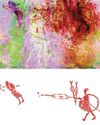
HUNTING EQUIPMENT
Hunting is known to be an ancient practice, but just how ancient was made clear by a discovery in a coal mine outside Schoningen, in northern Germany. There, archaeologists uncovered nine wooden spears, along with the remains of several dozen butchered horses. The spears have been dated to around 300,000 years ago, meaning they were likely used by early Neanderthals. This countered the belief of some scholars that early humans were scavengers who had not yet mastered hunting.
The spears, which measure around seven feet long, were produced by experienced weapon makers who planned their hunts in advance, says archaeologist Nicholas Conard of the University of Tubingen, who oversees excavations at Schoningen. All but one spear was made from spruce trees that had grown slowly in cold conditions, producing especially hardwood. The shafts were designed to be thicker, and therefore heavier, near the front, lending them greater stability in flight, and the tips were carved slightly off-center, to avoid the soft pith at the tree trunks’ cores. “They knew exactly what they were doing,” says Conard.
This story is from the May/June 2020 edition of Archaeology.
Start your 7-day Magzter GOLD free trial to access thousands of curated premium stories, and 8,500+ magazines and newspapers.
Already a subscriber ? Sign In
This story is from the May/June 2020 edition of Archaeology.
Start your 7-day Magzter GOLD free trial to access thousands of curated premium stories, and 8,500+ magazines and newspapers.
Already a subscriber? Sign In

A Very Close Encounter
New research has shown that human figures painted in red on a rock art panel in central Montana depict individuals engaged in a life-or-death encounter during an especially fraught historical moment.

A Sword for the Ages
A zigzag pattern, now tinged with the green-blue patina of oxidized metal, adorns the octagonal hilt of a rare sword dating to the Middle Bronze Age in Germany (1600-1200 B.C.) that was recently excavated in the Bavarian town of Nördlingen.

Ancient Egyptian Astrology
For centuries, layers of soot have coated the ceilings and columns in the entrance hall of Egypt's Temple of Esna. Now, an Egyptian-German team of researchers, led by Hisham El-Leithy of the Egyptian Ministry of Tourism and Antiquities and Christian Leitz of the University of Tübingen, is restoring the temple's vibrant painted reliefs to their original brilliance.

BRONZE AGE POWER PLAYERS
How Hittite kings forged diplomatic ties with a shadowy Greek city-state

RITES OF REBELLION
Archaeologists unearth evidence of a 500-year-old resistance movement high in the Andes

Secrets of Egypt's Golden Boy
CT scans offer researchers a virtual look deep inside a mummy's coffin

When Lions Were King
Across the ancient world, people adopted the big cats as sacred symbols of power and protection

UKRAINE'S LOST CAPITAL
In 1708, Peter the Great destroyed Baturyn, a bastion of Cossack independence and culture

LAPAKAHI VILLAGE, HAWAII
Standing beside a cove on the northwest coast of the island of Hawaii, the fishing village of Lapakahi, which is surrounded by black lava stone walls, was once home to generations of fishers and farmers known throughout the archipelago for their mastery of la'au lapa'au, or the practice of traditional Hawaiian medicine. \"

A MORE COMFORTABLE RIDE
Although the date is much debated, most scholars believe people 5,000 years ago. For thousands of years after that, they did so without saddles. \"In comparison with horse riding, the development of saddles began relatively late, when riders began to care more about comfort and safety in addition to the horse's health,\" says University of Zurich archaeologist Patrick Wertmann.